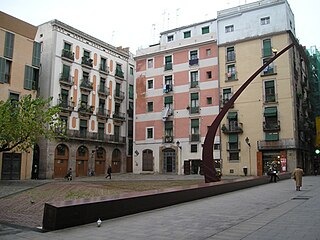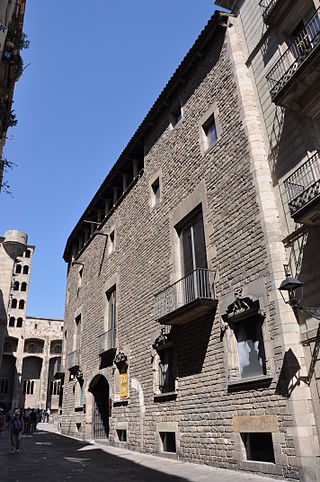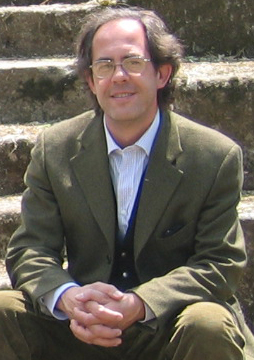
The Barcelona Roman amphitheatre is a disappeared and now invisible Roman amphitheatre in Barcelona, Catalonia, Spain. In addition, it's possible to suppose a Roman circus in another sector of the city.

The Barcelona Roman amphitheatre is a disappeared and now invisible Roman amphitheatre in Barcelona, Catalonia, Spain. In addition, it's possible to suppose a Roman circus in another sector of the city.
The leading proponent of the hypothesis, Spanish archaeologist Jordina Sales, [1] believes that some oval urban structures around the church Santa Maria del Mar, in the Ribera district, may indicate the ground plan. Argenteria street may be the vestige of the Roman via between the porta principalis sinistra, in the Roman wall (at the present, Angel square), and the doors of that amphitheatre. Currently, no solid archaeological or documentary evidence has been found.
Recently, another hypothesis has been published. The author believes that the amphitheatre was situated around the church Santa Maria del Pi , on the other side of ancient Barcino . Some of Dr. Sales' reasons are being used now to support an opposite idea. However, the author fails to cite the thesis that he contradicts, as if he were unaware of the earlier idea. [2]
Both the main axis of Santa Maria del Mar church and the axis of Born avenue are parallel. That suggest a possible "fossil" remain of an ancient urban structure. In the Middle Ages, fights between knights took place on this site. If we consider, in addition to this axis, the fossil urbanistic remains that Sales identified in Santa Maria square (an unexplained curved façade) and in Caputxes street (some arches, maybe the remains of the structure of a cavea), one can easily imagine a hypothetical circus possibly extended from Caputxes street to the Rec Comtal canal, under the modern Born market. This estimation is based on a comparison with the dimensions of the Tarragona Amphitheatre.
Other notable Roman amphitheatres have been found under built up cities after being lost such as the one under London's Guildhall Art Gallery.

The Fossar de les Moreres is a memorial square in Barcelona, adjacent to the basilica of Santa Maria del Mar. The plaza was built over a cemetery where defenders of the city were buried following the Siege of Barcelona at the end of the War of the Spanish Succession in 1714. The plaza features a memorial to the fallen Catalans of the war, with a torch of eternal flame and a heroic poem by Frederic Soler, "El Fossar de les Moreres".

Vilafranca del Penedès, or simply Vilafranca, is the capital of Alt Penedès county in Penedès, Catalonia, Spain. It is situated in the Penedès Depression on the left bank of the Foix River, and on the main axis of communication from Barcelona to Tarragona and Valencia, served by a Rodalies Barcelona line 4 and by the AP-7 autopista as well as by the C-243 towards Sant Sadurní d'Anoia, and C-15 roads to Vilanova i la Geltrú and Igualada respectively.

Argentona is a municipality in the comarca of the Maresme in Catalonia, Spain. It is situated on the south-east side of the granite littoral zone, to the north-west of Mataró. The town is both a tourist centre and a notable horticultural centre. A local road links the municipality with Cabrera de Mar and with the main N-II road at Vilassar de Mar.

Saint Cucuphas is a martyr of Spain. His feast day is 25 July but in some areas it is celebrated on 27 July to avoid conflict with the important feast day of Santiago, the patron saint of Spain. His name is said to be of Phoenician origin with the meaning of "he who jokes, he who likes to joke."

The history of Barcelona stretches over 2000 years to its origins as an Iberian village named Barkeno. Its easily defensible location on the coastal plain between the Collserola ridge (512 m) and the Mediterranean Sea, the coastal route between central Europe and the rest of the Iberian Peninsula, has ensured its continued importance, if not always preeminence, throughout the ages.

La Ribera is one of the areas of the quarter of Sant Pere, Santa Caterina i la Ribera of Ciutat Vella of Barcelona.

Martí de Riquer i Morera, 8th Count of Casa Dávalos was a Spanish literary historian and Romance philologist, a recognised international authority in the field. His writing career lasted from 1934 to 2004. He was also a nobleman and Grandee of Spain.

Port Vell is a waterfront harbor in Barcelona, Catalonia, Spain, and part of the Port of Barcelona. It was built as part of an urban renewal program prior to the 1992 Barcelona Olympics. Before this, it was a run-down area of empty warehouses, railroad yards, and factories. 16 million people visit the complex each year.

The Temple of Augustus in Barcelona was a Roman temple built during the Imperial period in the colony of Barcino. The temple was the central building on Tàber Hill, currently in Carrer del Paradís number 10, in the city's so-called Gothic Quarter. The dedication to Augustus is traditional, but unproven.

The Boquer Valley is a scenic valley running 3 kilometres (1.9 mi) north-east from the town of Port de Pollença, Majorca, to the sea at Cala Boquer. It is popular with bird-watchers for its migratory birds and resident Blue Rock Thrushes.

The Museum of the History of Barcelona is a history museum that conserves, researches, communicates and exhibits the historical heritage of the city of Barcelona, from its origins in Roman times until the present day. The museum's headquarters are located on Plaça del Rei, in the Barcelona Gothic Quarter. It also manages several historic sites all around the city, most of them archaeological sites displaying remains of the ancient Roman city, called Barcino in Latin. Some others date to medieval times, including the Jewish quarter and the medieval royal palace called the Palau Reial Major. The rest are contemporary, among them old industrial buildings and sites related to Antoni Gaudí and the Spanish Civil War.

Monumental church complex of Sant Pere is a Bien de Interés Cultural landmark in Terrassa, Province of Barcelona, Spain. The Romanesque complex of churches includes Sant Pere, Sant Miquel and Santa Maria. They are situated at the confluence of Vallparadís and Monner, the most important artistic area of the city, which is noted for Catalan Romanesque art. It was the site of the former Diocese of Egara, an old Visigoth nucleus, in the 5th-8th centuries.
Pyrenae, Revista de Prehistòria i Antiguitat de la Mediterrània Occidental / Journal of Western Mediterranean Prehistory and Antiquity, is a biannual peer-reviewed academic journal of archaeology published by the Secció de Prehistòria i Arqueologia of the University of Barcelona. The journal focuses a chronological framework that ranges from prehistory to the beginning of the Middle Ages, especially in the Western Mediterranean. The editor-in-chief is Gisela Ripoll.

The Amphitheatre of Capua was a Roman amphitheatre in the city of Capua, second only to the Colosseum in size and probably the model for it. It may have been the first amphitheatre to be built by the Romans. and was the location of the first and most famous gladiator school.

Xavier Dupré i Raventós was a Spanish archaeologist and historian of classical antiquity. He was the first provincial archaeologist appointed by the archaeological division of the Generalitat de Catalunya in Tarragona. He was also director of Taller–Escola d’Arqueologia de Tarragona (TED’A), director of excavations of the Roman city of Tusculum and deputy director of the Escuela Española de Historia y Arqueología in Rome.

The following outline is provided as an overview of and topical guide to Barcelona:

The Roman amphitheatre of Italica is a Roman amphitheatre in the Roman colonia of Italica –in present-day Santiponce (Seville), Spain–, in the Roman province of Hispania Baetica. Built during the reign of emperor Hadrian, approximately between the years AD 117 and 138, it was one of the largest in the entire Roman Empire with a capacity of 25,000 spectators. It was used for gladiatorial fights and combats between beasts or men and beasts during ancient Rome.

The Anfiteatro Correa was an amphitheatre in 1870 in Rome, Italy and was later known as the Anfiteatro Umberto I. In 1908, the threatre was transformed into a concert hall known as the Teatro Augusteo.

The Roman walls of Barcelona are an archaeological and monumental complex made up of the remains of the ancient wall built in the time of the Roman Empire, between the 1st century BC and the 4th century AD. C. and the 4th century BC. They are located in the Gothic Quarter, in the Ciutat Vella district of Barcelona.